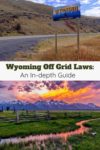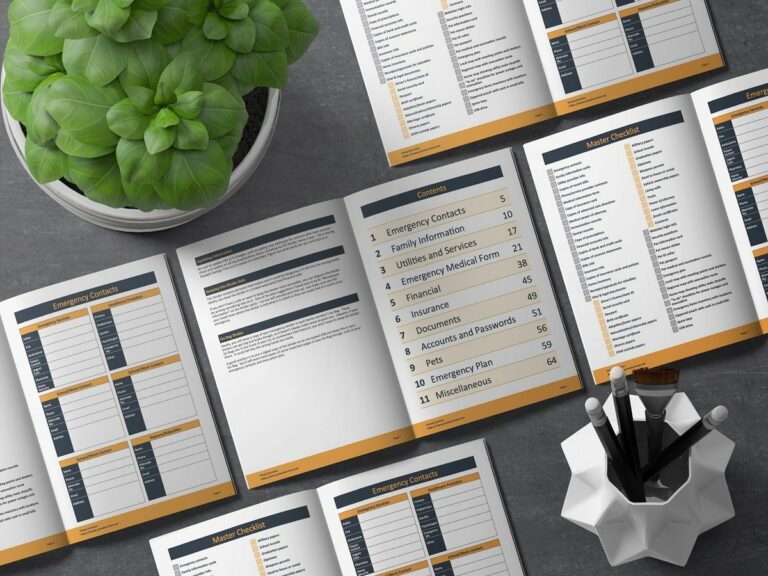Wyoming is famous for its rugged landscapes, open spaces, and the self-reliant mentality of residents. These qualities draw many people to the state, wanting to live entirely off the grid. Before you buy property, though, it’s essential that you fully understand the off grid laws of Wyoming.
Want to know more about living off grid? Read:
- Off Grid Rules of Every State in America
- How Much Does It Cost To Live Off The Grid?
- Which Places in the USA Are Best for Homesteading?
Is Living Off-Grid Legal in Wyoming?
Living off-grid is completely legal in Wyoming. Because of its relaxed regulations and many areas without zoning rules, it is one of the easiest places to go off-grid in the United States. The main legal issue is getting water rights, especially if you need to irrigate a large property or livestock.
Wyoming Zoning Laws and Off-Grid Living
Zoning laws dictate what you are allowed to do on your property. In some places, zoning laws can be stringent and regulate everything from the height of fences to whether you can have chickens.
Luckily, you aren’t likely to come across zoning issues in Wyoming.
The State legislature does not require counties to have zoning rules; they only require land use plans. There are even many places in Wyoming without zoning, which means you are essentially allowed to do whatever you want on your property.
Places in Wyoming without Zoning
Below is a list of Wyoming counties and whether they have zoning. Note that the rules are usually very relaxed even in places with zoning. The rules mainly apply to subdivisions and not remote rural properties.
Zoning regulations do change, so check for updated zoning rules before purchasing property in Wyoming.
- Albany County: Zoning
- Big Horn: Partial zoning
- Campbell: Partial zoning
- Carbon: Zoning
- Converse: No zoning
- Crook: No zoning
- Freemont: Partial zoning
- Goshen: No zoning
- Hot Springs: Partial zoning
- Johnson: No zoning
- Laramie: Partial zoning
- Lincoln: Zoning
- Natrona: Zoning
- Niobrara: Partial zoning
- Park: Zoning
- Platte: Zoning
- Sheridan: Zoning
- Sublette: Zoning
- Sweetwater: Zoning
- Teton: Zoning
- Unita: Zoning
- Washakie: No zoning
- Weston: No zoning
Building Codes in Wyoming
Wyoming does not have statewide building codes, and most places without zoning have not adopted any codes. For example, Johnson County does not have building codes or require building permits.
Some Wyoming counties and cities have adopted building codes. However, compared to the USA as a whole, the regulations tend to be very relaxed. For example, Sheridan County only requires a building permit for projects over $3,000, new buildings larger than 200 square feet, or specific electrical, plumbing, or mechanical work.
This doesn’t mean you shouldn’t follow codes (such as the International Building Code) when building on your property, but it does mean that you don’t have to go through an arduous and expensive permitting process before you start your project.
Mobile Homes
Because many parts of Wyoming have no zoning, the state is very friendly towards mobile home living. Without zoning, nothing is stopping you from living in whatever type of home you want.
In places with zoning, such as the city of Cody, you will encounter more legal issues if you want to live in a mobile home. You can only live in a mobile home in certain zoning districts.
Tiny Home Rules in Wyoming
In areas without zoning, nothing is stopping you from living in a tiny home in Wyoming. However, in some places with zoning, it’s important to note that tiny homes might fall under one of these two definitions:
- Manufactured home: Manufactured homes are built in a plant and are transported in one or more sections on a permanent chassis. Manufactured homes are further classified as follows: 1. “Multi-wide” (AKA double-wide or triple-wide manufactured home) has a minimum width of at least eighteen feet as measured at all points perpendicular to the length of the manufactured home; 2. “Single-wide” has a width of less than eighteen feet as measured at any point perpendicular to the length of the manufactured home.
- Modular home: A residential dwelling constructed of pre-made parts and modules manufactured at a facility, in which parts and modules are transported to a fixed site, placed by crane, and permanently affixed to and supported by a perimeter foundation. Manufactured homes and other dwellings with a permanent chassis designed for purposes of transporting and supporting the structure, cannot qualify as modular homes, as defined herein. A modular home is considered equivalent to a sitebuilt home for zoning purposes.
You will have an easier time with zoning if your tiny house qualifies as a “modular home” instead of a manufactured home. It will need a permanent foundation.
Off-Grid Electricity in Wyoming
There are no laws preventing you from disconnecting from the power utility in Wyoming and going off-grid. The state laws are generally very favorable towards solar and wind energy systems. You do not need a permit to install solar energy systems in many places and can even do the installation yourself. Requirements for wind power systems are usually stricter. You can read the rules here.
Solar equipment is exempt from sales tax, and the state offers rebates on equipment costs. However, solar equipment is not exempt from property taxes.
Wyoming is a good state when it comes to grid-tied renewable electricity. Lawmakers recently tried to get rid of net metering. Luckily, the law didn’t pass, and the state still has a pretty good net metering policy.
Also Read:
Off-Grid Water Laws in Wyoming
Much of the state is in drought conditions except for a few areas in the north, central, and southeast of Wyoming.
Because of this, getting water for your off-grid property could be difficult. You won’t be able to use any water without obtaining a permit from the state engineer’s office.
While getting water rights for domestic use is usually relatively simple, you might encounter legal issues if you need water to irrigate a farm or livestock.
- You can read the details of Wyoming water rights laws here.
- The State Engineer Office has a very useful website here.
- See the Wyoming drought monitor map here.
Who Owns the Water in Wyoming?
All natural streams, springs, lakes, and other still water in Wyoming belong to the state.
The state does not recognize riparian rights: just because there is water on your property does not mean you have the right to use it. Instead, Wyoming follows the doctrine of prior appropriation: whoever puts the water to beneficial use first has the first right to use the water.
In times of drought or water scarcity, senior water rights holders get to use the water before junior water rights holders. There is an exception: groundwater wells yielding 25 gpm or less and used only for domestic or stock purposes have preferred rights, regardless of priority date.
Surface Water Laws in Wyoming
Before using any surface water in Wyoming – including water on or next to your property – you must apply for a permit with the state engineer. You’ll need to have an engineer or surveyor licensed in the state prepare documentation for the permit application. If your permit is granted, you must file additional paperwork after the water is put to use.
Water rights obtained after 1985 are entitled to 2 cfs per 70 acres. If water is scarce, you are entitled to 1 cfs per 70 acres, but only after senior water rights holders have received their allotment.
Diverting Surface Water
To divert a stream or other body of water, you must apply for an in-stream flow permit. The state engineer must conduct a public hearing before granting a permit.
Digging a Pond on Your Property
Digging a small pond or reservoir on your property is legal in Wyoming. You still must file a permit but only need to file a simplified form, so long as the pond:
- Is for stock or fishing
- Has a capacity of 20 acre-feet or less
- The height of the damn does not exceed 20 feet
Well Water Laws in Wyoming
Even groundwater in Wyoming belongs to the state. You will need a permit from the state engineer to dig and use water from a well. As with surface water, the doctrine of prior appropriation applies to groundwater.
Despite drought conditions, domestic wells are almost always granted a permit (though there are some exceptions, such as in places where the groundwater levels are already very low and conflicts are likely to occur).
Under the law, a domestic well is defined as:
- Used solely for household uses, including watering lawns and gardens for non-commercial family use
- The area to be irrigated does not exceed 1 acre
- Does not exceed 25gpm
- Supplies a maximum of 3 single-family dwellings, and the total area of lawns and gardens watered does not exceed 1 acre
Stock watering wells are also easily granted permits. These are defined as wells with piped water going to no more than four points within 1 mile of the well.
Any groundwater appropriation over 25 gpm is considered a surface spring.
Rainwater Harvesting
The Wyoming State Engineers Office currently has no laws regulating rainwater harvesting or rain gardens. This makes collecting as much rainwater as you want in barrels or tanks legal.
Many places even encourage residents to collect rainwater. For example, Laramie City and Casper City websites have instructions on how to make your own rain barrels. Some cities may have regulations about which types of tanks are allowed, and you may need a building permit for underground rainwater storage cisterns.
Also Read:
Sewage and Waste Removal Laws in Wyoming
In Wyoming, the Division of Environmental Health regulates sewage and wastewater systems that discharge less than 2,000 gallons per day. Non-domestic systems larger than 2,000 gallons per day are regulated by the Wyoming Department of Environmental Quality.
Even if your county has not adopted building codes, you will still need to get a permit for your sewage system. In many cases, you must also have your system inspected before it can be legally used.
Go to the Wyoming Secretary of State website to read the complete regulations. Click “Environmental Quality, Dept. Of” and select “Chapter 25: Septic tanks, soil absorption systems, and other small wastewater systems.”
Are Compost Toilets Legal in Wyoming?
According to the Wyoming DEQ, composting toilets are legal. You do not need a permit for a portable compost toilet. Permanently-installed compost toilets do require a permit.
The state wastewater law only mentions compost toilets once. It says, “Composting or non-discharging toilets, where permitted, shall have their waste disposed of at a permitted wastewater treatment system or landfill, or in a manner approved by the Division or delegated authority.”
Because the law is so vague, it leaves it up to local counties to decide whether compost toilets can be legally used. It is most likely that compost toilets will follow the same rules as outhouses: they are legal as your only toilet, but only if you also have an approved greywater disposal system.
Also Read:
Are Outhouses Legal in Wyoming?
Outhouses are legal in Wyoming. They are even legal in more populated areas like Laramie, WY. You will need to get a permit to use an outhouse legally. However, depending on the county, rules may restrict you from having an outhouse. For example, having an outhouse in Wyoming within a 100-year floodplain is usually illegal. You’ll also need an approved greywater system if you have running water in your home.
Wyoming Greywater Rules
Wyoming law is very favorable towards greywater recycling and reuse. Using greywater from your home to irrigate crops or flush toilets is legal. You will need to get a permit, and there are some regulations. For example, in Sheridan County, greywater cannot leave the property where it originated and cannot be more than 2,000 gallons per day. If using greywater to irrigate food crops, you must wait 30 days after contact with greywater to harvest the crop. In some situations, such as when the greywater is discharged onto the ground surface, you must disinfect it first.
Also Read:
Do you live off-grid in Wyoming? Let us know about your experiences in the comments section below.


